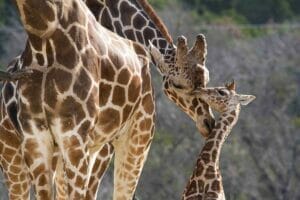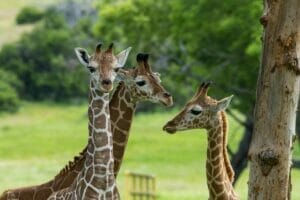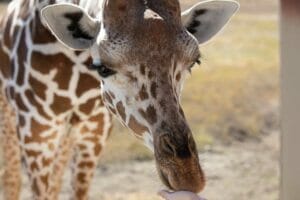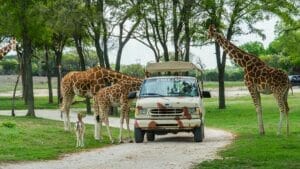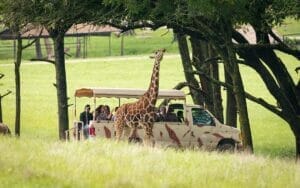
Appearance
Giraffes are the undoubtedly the world’s tallest living land mammals, standing on average at 16-19 feet. Besides their height, giraffes are easily identified by their spot patterns. These patterns are completely unique to each individual, similar to a human fingerprint, and help the species blend in while standing under trees. Instead of horns, giraffe have bony knobs, or ossicones, atop their heads which are formed by cartilage covered skin and hair. Females only have two, while some bulls occasionally have three.
Adaptations
Giraffes mouths are velvety soft, thanks to a hairy upper lip as well as a long, purplish tongue that can grip items like a finger. The tongue’s color acts as a natural sunscreen while it’s outside of the mouth, while the soft lips and saliva help protect the giraffes from thorny foliage.
Giraffe’s necks contain seven vertebrae, the same amount as a human neck. However, despite its length, the neck is too short to reach the ground. As a result, giraffes have to spread their legs precariously or kneel down to take a drink. Their ability to get that drink and then jerk their heads up to scout for predators without fainting is the result of an amazing circulatory system. This system is so revolutionary that it has been studied by NASA to find ways to prevent blackouts at high altitudes.
Giraffes walk at a leisurely pace unless disturbed. When pursued or fighting, they can run up to 35 mph. Giraffes fight by charging and swinging their heads at each other as hard as they can. Although violent, these fights do not result in injury because the males’ six-inch ossicones are blunt and covered with skin, while the skin on their necks can be an inch thick. Not only are their heads powerful, but giraffes are able to defend themselves from predators with a powerful kick using the front or hind legs.
Conservation
Although giraffes are not considered fully endangered, their populations have seen a sharp decline since the 1980’s. According to recent findings, there may be at least four distinct giraffe species as well as five subspecies, each requiring different considerations when it comes to conservation. By learning more about the differences between giraffes and their subspecies, we can better understand how to help their populations. Regardless, we do know that habitat loss due to climate change and human intervention is one of the major factors driving giraffes out of their original range.
Where are they?
Giraffe live in the fourth pasture you enter. They are usually found near their barn, but will wander throughout the space.
VIEWING TIPS
When you try to feed the giraffes, put some pellets in your hand and elevate your palm flat above your head so the giraffe can easily see it to approach you. If the temperature is below 50 degrees, they may be put in their barn.
Quick Facts
Scientific Name | Giraffa camelopardalis |
Species Survival Plan | Yes |
Habitat | Savanna |
Food | Leaves, shoots, flowers; acacia leaves are its favorite |
Originally Native To | Northeast Kenya |
Height | 14 - 17 feet |
Characteristics | Light brown to dark chestnut broken up into patches and blotches by a network of light-colored hair; split hooves 12 inches across; tail ends in tuft |
Lifespan | Wild 25 years |
Social Behavior | Form loose groups that may include different sexes and ages |


